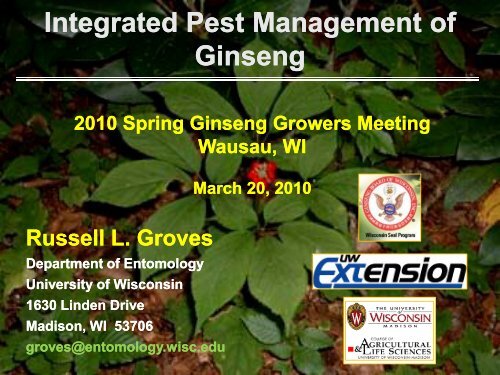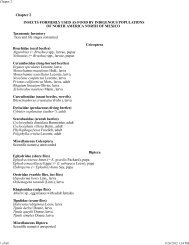Integrated pest management of ginseng - Russell Labs Site Hosting
Integrated pest management of ginseng - Russell Labs Site Hosting
Integrated pest management of ginseng - Russell Labs Site Hosting
Create successful ePaper yourself
Turn your PDF publications into a flip-book with our unique Google optimized e-Paper software.
<strong>Integrated</strong> Pest Management <strong>of</strong>Ginseng2010 Spring Ginseng Growers MeetingWausau, WI<strong>Russell</strong> L. GrovesDepartment <strong>of</strong> EntomologyUniversity <strong>of</strong> Wisconsin1630 Linden DriveMadison, WI 53706groves@entomology.wisc.eduMarch 20, 2010
Presentation Outline1) Current challenges <strong>of</strong> managing insect<strong>pest</strong>s2) Key insect <strong>pest</strong>s <strong>of</strong> <strong>ginseng</strong> and newinsecticide products3) Novel delivery systems for water-solubleinsecticides
Wisconsin Vegetable Production Statistics(Wis. Ag. Stats. 2008)Major cropsCrop Nat. Rank Acres% <strong>of</strong>U.S.$ Value(millions)Potatoes 3 64,500 6 $242Sweet corn (Proc) 1 88,900 21 $81Sweet corn (Fresh) -- 7,700 -- $14Snap beans 1 82,300 38 $62Peas 3 40,200 21 $20Minor cropsCucumbers (pickles) 4 7,100 8 $9Cabbage (fresh)Cabbage (kraut)CarrotsOnions (storage)Small-acreage fresh market production continues toexpand. Anecdotal statistics estimate ca. 1,900small-acreage producers that grow over 50 cropsin WisconsinGinseng 1 1,650 81% $58
Macro-Factors InfluencingInsect Pest Management• Increasing population and changing demographics• Changes in food consumption• Decreasing arable land• Decreasing availability <strong>of</strong> water• Food safety• Concern for the environment• Global agricultural trade
Factors Influencing Insect Pest Management„Food Safety‟– Major food retailers are setting acceptable residue levelsbelow those set by government regulatory agencies.“No detectable residues” will be a competitiveadvantage for food retailers.– Older insecticides that do not meetthese requirements are not beingre-registered, registered, resulting in increaseduse <strong>of</strong> novel insecticides(bio-<strong>pest</strong>icides).
Factors Influencing Insect Pest Management„Environmental Concerns‟– With increasing affluence reaching the developing world,there will be increasing concerns about <strong>pest</strong>icide usage andperceived environmental effects.– This will accelerate the shift to “s<strong>of</strong>ter” products andtechnologies.
Factors Influencing Insect Pest Management„Water Quantity and Quality‟• Decreasing availability <strong>of</strong> water for agriculture- Agriculture is the overwhelming user <strong>of</strong> fresh water.- Increasing urban demand will drive irrigationefficiency.• Drip irrigation, micro-sprinklers, hydroponics.• Targeted application <strong>of</strong> waterincreases opportunity to useirrigation as a delivery system.
Wisconsin Insect Pest ManagementOptions for Insect Pest Management – More than ever before!Cultural controlsHost plantresistanceTransgenic plantsIR traitsNaturalenemiesVegetableIPMReduced-Risk ChemicalInsecticidesBaits andbaiting systemsPopulationdisruptionEntomopathogens
Presentation Outline1) Current challenges <strong>of</strong> managing insect<strong>pest</strong>s2) Key insect <strong>pest</strong>s <strong>of</strong> <strong>ginseng</strong> and newinsecticide products3) Novel delivery systems for water-solubleinsecticides
Varied Ginseng Insect PestsKey PestsWirewormsWhite GrubsCutworms - armywormsSporadic PestsFour-lined plant bugsLeaf rollersAphidsIntermittent PestsThripsScaleMealybugsStem borersWhite grub (Phyllophaga spp.)
Ginseng Insect PestsPest Management Strategic Plans (Hausbeck 2007)Top research priorities identified during the2007 PSMP Workshop:1) Identify new active ingredients effective against grubs,cutworms and wireworms; and2) Identify pathogens that may be seedborne and identifyeffective treatments;3) Develop <strong>management</strong> strategies for root rot diseases,including Phytophthora, Cylindrocarpon, and Fusarium.
Mint Insect Control:Variegated & Black Cutworm‣ Early season leaf damage/ stand lossVariegated cutworm larvae‣ Mid to later season leafdamage / localizedBlack Cutworm
Cutworm & Looper ControlEstablished Thresholds: Undetermined(2-3 larvae ft 2 )Early Season:Diazinon AG600 WBC (0.75 – 1.0 pt / ac)Candidate Options:Bifenture EC (0.08 - .1 lb ai/ac)Coragen (0.046 – 0.065 lb ai/ac)Avaunt 30 WDG (0.065– 0.11 lb ai/ac)Radiant SC (0.03-0.090.09 lb ai/ac) (2008)Variegated cutworm:early larvae
Reduced-Risk Risk FoliarRegistrations (2009-10)‣ Radiant ® SC (spinetoram)Macrocyclic lactone (spinosad: MoA group 5)Use rate 4 - 12 oz / ac (Lepidoptera)10-14 14 days persistence (improved photostability)Very low impact on beneficials‣ Coragen TM (chlorantraniliprole)Anthranilicdiamide (MoAgroup 28)Use rate 3 - 6 oz (Lepidoptera) +MSO 5% v/v14+ days persistenceVery low impact on beneficials and low toxicityOvicidalactivityIR-4,Under reviewCorn earworm larvae„dead‟
Wireworms & White GrubsWhite grub (June beetle)2-3 year life cycleAdults lay eggs in grassLarvae feed on tubers 2-3 yearsWireworm (click beetle)4-6 year life cycleAdults lay eggs on grassLarvae feed 3-5 years on tubers
Wireworms & White Grubs‣ Soil-dwelling larvae (grubs) <strong>of</strong> June and click beetles‣ Worldwide in distribution‣ Many different species, all with unique lifecycles‣ Can be a <strong>pest</strong> on a wide range <strong>of</strong> crops:- cereals, vegetables, s<strong>of</strong>t fruit, and potatoesWhite grub larvaWireworm larvae
Generalized Wireworm Lifecycles‣ Varied, taking 3 – 4 years to develop from egg to adult.‣ Nearly all spent in larval stages: egg & pupa = 1 month‣ Overwinter at 10 – 24”, movement > 55 o F‣ Females emerge to mate, then burrow and re-emerge emerge to ovipositBeetleEmergenceEggsEggs1 styearlarvae2 ndyearlarvae3 rdyearlarvae4 thyearlarvae
Wireworm DamageSweetpotatoTransplantCucumbersField cornPeanutsBeans
Wireworm Risk Assessments:Surveillance and Monitoring‣ Placement <strong>of</strong> bait stations: spring or fall withwarm soils.‣ Polyethylene to warm the surrounding soiland liberate CO 2 .‣ Be mindful <strong>of</strong> field history for placement.Problems have <strong>of</strong>ten been associated with pastcropping history (e.g. grasses).‣Pheromone traps: (future evaluation needed)
Wireworm Action Thresholds:Interpreting Trap CountsMean No.wireworms perstationRisk <strong>of</strong> Damage0 Low (< 10%)< 0.5 Moderate (33%)IPMRecommendationControl NotNeededResample soil0.5 < X < 1.0 50:50 Resample soil1.0 < X < 2.0 Probable (> 50%)2.0 < X < 4.0 High (> 75%)> 4.0 ExtremeResample soilApply insecticideat-plantingDo not plant
Mean percent wireworm damageSummary <strong>of</strong> wireworm insecticidetrials-Kuhar et al. 200730252002-20052005 WirewormControl Summary2015On average, all treatments provide ~60-70% control1050A dmire +R egentP latinum +R egentT himet o rM o cap(standard)P latinum +C aptureA dmire +C aptureR egent 3.5fl o zA dmire 16 flozP latinum 8fl o zC apture 19fl o z(bro adcast)UT CInsecticide Treatment
Physical placement <strong>of</strong> insecticides:In potato furrow at plantingPotato seed and in-furrow, bandedinsecticide in newly planted fieldDeveloping crop and residualinsecticide at harvest
Possible explanations for increasingdamage to crops• Increased rotations with grasses for soilconservation or small grain, corn production• Relatively mild winters in the last several years• Changes in the culture <strong>of</strong> primary rotationcrops• The loss <strong>of</strong> registration <strong>of</strong> insecticides withlong residual soil activity– “Older chemistries (slated for removal by EPA-FQPA) are finally dissipating”. Some materials hada half-life life <strong>of</strong> 20 years.
Important Considerations‣ Broadcast treatments sometimes work betterthan in-furrow treatments, or vice versa.-Broadcast good in field with random sources<strong>of</strong> C0 2 (i.e. green manure).-In-furrow good in well fallowed fields.‣ Treatments expected to work well (e.g. Thimet)sometimes give mediocre results.‣ It should be noted, land prep is a critical variable andshould always be considered and recorded.‣ For growers, they should be informed that competingCO 2 sources at planting (e.g. green manure) will reduce<strong>pest</strong>icide efficacy.
Another Explanation: Climate andSpecies CompositionD. A. Johnson, 2008
Not all wireworms are created equal‣ Different species <strong>of</strong> wireworms express differentresponses to insecticides, leading to:-Varying levels <strong>of</strong> crop protection (e.g. potato)-Varying levels <strong>of</strong> intoxication-Varying levels <strong>of</strong> mortality-Varying levels <strong>of</strong> repellency‣ Knowing the wireworm(s) we are dealing to thespecies level is a must if we want to accurately reportand compare data.
‣ Bt transgenics:Changing CulturalManagement <strong>of</strong> Field Corn- Activity against European corn borer, corn earworm, rootworms,cutworms, and armyworms: not wireworm.‣ Adoption <strong>of</strong> transformants continues to increase:- 2004 (22%) to 2007 (49%)‣ RR Technology has lead to grass competition: armyworm- Burn down dates have been extended.‣ Land removed from conservation reserve program (CRP):
Difficult Pest Management• Incomplete understanding <strong>of</strong> wirewormbiology• limited availability <strong>of</strong> completely effectivechemicals• lack <strong>of</strong> efficient and labor-friendly monitoringtools which would allow growers to predictlikelihood <strong>of</strong> damage or to assist in decisionsabout the necessity <strong>of</strong> insecticide treatment
Presentation Outline1) Current challenges <strong>of</strong> managing insect<strong>pest</strong>s2) Key insect <strong>pest</strong>s <strong>of</strong> <strong>ginseng</strong> and newinsecticide products3) Novel delivery systems for water-solubleinsecticides
Drip Application for Insect Control(Cucurbits, Fruiting Vegetables,Brassicas, Potatoes)• Why use drip irrigation for insecticideapplications?• What insects are controlled with dripapplication?• Regulations and tips for best results <strong>of</strong>drip chemigation.
Pesticide Drift• Amount <strong>of</strong> <strong>pest</strong>icide lost due to drift estimated at 5to 65%.• Less than 0.1% <strong>of</strong> <strong>pest</strong>icide reaches target insect.• Consequences <strong>of</strong> <strong>pest</strong>icide drift– Exposure <strong>of</strong> humans– Exposure <strong>of</strong> water resources– Exposure <strong>of</strong> wildlife
Limitations <strong>of</strong> Spraying Insecticides• Weather conditions– Wind– Rain– Wash-<strong>of</strong>f• Re-entry intervals• Pre-harvest intervals
Advantages <strong>of</strong> Drip Application <strong>of</strong>Insecticides• Reduced risk to environment and farmworkers– Drift to non-target areas is eliminated– Farm workers do not come into contact withresidues on exterior <strong>of</strong> plant– Beneficial organisms not directly exposed• Longer residual activity– Not subject to loss from rain and UV light– Not subject to plant growth dilution effects• More cost-effective
What Insecticides Can Be Applied in DripIrrigation Systems• Must move systemically through plant.• Label must specifically state that productcan be applied via drip irrigationNeonicotinoids Diamides CarbamatesAdmire Coragen VydatePlatinumSynapseVenom**HGW86Durivo
Thiamethoxam & Imidacloprid Platinum 75SG (1.7 – 4.0 fl oz/ac) Admire Pro (4.4 – 10.5 fl oz/ac)– Brassicas, Cucurbits,Fruiting Veg, Potato, and GinsengWhite grubWireworm Spectrum <strong>of</strong> Activity– Wireworms, white grubs, plant bugs– Suppression <strong>of</strong> aphids, thrips, whitefliesAphids Systemic activity– Labeled for foliar and dripirrigation applicationPlant bugs
Chlorantraniliprole(Rynaxypyr)• Coragen 1.67SC**– Brassicas, Cucurbits,Fruiting Veg, Leafy Veg, PotatoVariegated cutworm• Spectrum <strong>of</strong> Activity– Lepidopterans, some beetles (CPB)– Wireworm and white grubsuppression at higher ratesBlack cutworm• Systemic activity– Labeled for foliar and drip irrigation application**Not currently labeled for Ginseng
Chlorantraniliprole + ThiamethoxamDurivo 1.67SC**– 2:1 mixture <strong>of</strong> thiamethoxam & chlorantraniliprole– Brassicas, Cucurbits, Fruiting Veg, Leafy Veg• Spectrum <strong>of</strong> Activity– Lepidopterans, leafhoppers, cucumber beetle– Aphids, Beetles, Plant & Stink Bug, Thrips, Whitegrubs and Wireworms–• Drip application only, 1 application/year.• 5-day REI for honeybees.**Not currently labeled for Ginseng
Drip Irrigation <strong>of</strong>Insecticides
ATCP 29 Rule, Pesticide Use and Control,Revised September 2009. ATCP 29.54Chemigation.http://datcp.state.wi.us/cp/consumerinfo/cp/cp_laws/<strong>pest</strong>icides/<strong>pest</strong>icide_use.pdf
For Best Results with Drip-AppliedInsecticides• Repair all leaks before chemigating.• Before injection <strong>of</strong> insecticide begins,system must be fully pressurized.• Minimum injection time should be time forwater to move from injection point to mostdistant emitter.• Water solubility and soil texture affectsmovement in soil, and timing <strong>of</strong> injection.– Low solubility = limited movement– High solubility = readily moves in soil
Conclusions• Drip application <strong>of</strong> insecticides <strong>of</strong>fers severaladvantages over foliar application, includingsafety, flexibility and longer residual control.• Combinations <strong>of</strong> several insecticides withdifferent MoA can achieve broad spectruminsect control.• Be sure irrigation system is legal forchemigation, and provides uniformdistribution <strong>of</strong> water.
AcknowledgementsWisconsin Ginseng GrowersQUESTIONS ?

















